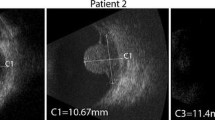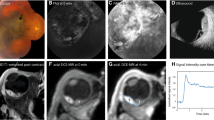Abstract
MRI of uveal melanoma using 1.5-T technology and surface coils has developed into a standard procedure. The purpose of the study was to evaluate the feasibility of 3.0-T technology in eye imaging. To optimize the MRI sequences for clinical eye imaging with 3.0-T, six healthy volunteers were conducted using a 4.0-cm surface coil. Evaluation criteria were the signal-to-noise-ratio (SNR), contrast-to-noise-ratio (CNR) and image quality. A further six patients with uveal melanoma were examined with 1.5- and 3.0-T under retrobulbar anesthesia. During 3.0-T examinations of volunteers, eye movements caused significant artifacts. On the contrary, excellent imaging quality was reached in examinations of patients under retrobulbar anesthesia at 3.0 T. Subjective assessment showed no significant difference between 1.5 and 3.0 T in patients. Due to the increased SNR, the 3.0-T technique has the potential to improve eye imaging, but the higher susceptibility to motion artifacts limits the clinical use of this technique to patients receiving retrobulbar anesthesia.





Similar content being viewed by others
References
Mahoney MC, Burnett WS, Majerovics A et al (1990) The epidemiology of ophthalmic malignancies in New York State. Ophthalmology 97:1143–1147
Shields JA, Shields CL (1993) Current management of posterior uveal melanoma. Mayo Clin Proc 68:1196–1200
Seddon JM, Gragoudas ES, Albert DM (1983) Ciliary body and choroidal melanomas treated by proton beam irradiation. Histopathologic study of eyes. Arch Ophthalmol 101:1402–1408
Journee de Korver JG, Oosterhuis JA, Kakebeeke Kemme HM et al (1992) Transpupillary thermotherapy (TTT) by infrared irradiation of choroidal melanoma. Doc Ophthalmol 82:185–191
Oosterhuis JA, Journee de Korver HG, Kakebeeke Kemme HM et al (1995) Transpupillary thermotherapy in choroidal melanomas. Arch Ophthalmol 113:315–321
Shields JA, Shields CL (1988) Surgical approach to lamellar sclerouvectomy for posterior uveal melanomas: the 1986 Schoenberg lecture. Ophthalmic Surg 19:774–780
Foulds WS (1973) The local excision of choroidal melanomata. Trans Ophthalmol Soc U K 93:343–346
Foulds WS, Damato BE, Burton RL (1987) Local resection versus enucleation in the management of choroidal melanoma. Eye 1:676–679
Lemke AJ, Hosten N, Bornfeld N et al (1998) Appearance of choroidal melanoma on high resolution MRI using 1.5 T with a dedicated surface coil in 200 consecutive patients. RoFo Fortschr Geb Rontgenstr Neuen Bildgeb Verfahr 169:471–478
Bernstein MA, Huston Jr, Lin C et al (2001) High-resolution intracranial and cervical MRA at 3.0 T: technical considerations and initial experience. Magn Reson Med 46:955–962
Frayne R, Goodyear BG, Dickhoff P et al (2003) Magnetic resonance imaging at 3.0 Tesla: challenges and advantages in clinical neurological imaging. Invest Radiol 38:385–402
Haider MA (2003) Extending PowerPoint with DICOM image support. Radiographics 23:1683–1687
Takahashi M, Uematsu H, Hatabu H (2003) MR imaging at high magnetic fields. Eur J Radiol 46:45–52
Schmitt F, Grosu D, Mohr C et al (2004) Three-Tesla MRI: successful results with higher field strengths. Radiologe 4:31–47
Wolfsberger S, Ba-Ssalamah A, Pinker K et al (2004) Application of three-Tesla magnetic resonance imaging for diagnosis and surgery of sellar lesions. J Neurosurg 100:278–286
Graf H, Schick F, Claussen CD et al (2004) MR visualization of the inner ear structures: comparison of 1.5 Tesla and 3 Tesla images. RoFo Fortschr Geb Rontgenstr Neuen Bildgeb Verfahr 176:17–20
Rouviere O, Hartman RP, Lyonnet D. Prostate MR imaging at high-field strength: evolution or revolution? Eur Radiol 2005 Sep 10; [Epub ahead of print]
Naganawa S, Koshikawa T, Fukatsu H et al (2002) Fast recovery 3D fast spin-echo MR imaging of the inner ear at 3 T. AJNR Am J Neuroradiol 23:299–302
Naganawa S, Koshikawa T, Nakamura T et al (2004) Comparison of flow artifacts between 2D-FLAIR and 3D-FLAIR sequences at 3 T. Eur Radiol 14:1901–1908
Lenk S, Ludescher B, Martirosan P et al (2004) 3.0 T high-resolution MR imaging of carpal ligaments and TFCC. RoFo Fortschr Geb Rontgenstr Neuen Bildgeb Verfahr 176:664–667
Nobauer-Huhmann IM, Ba-Ssalamah A, Mlynarik V et al (2002) Magnetic resonance imaging contrast enhancement of brain tumors at 3 Tesla versus 1.5 Tesla. Invest Radiol 37:114–119
Schick F (2005) Whole-body MRI at high field: technical limits and clinical potential. Eur Radiol 15:946–959
Lutterbey G, Gieseke J, von Falkenhausen M et al (2005) Lung MRI at 3.0 T: a comparison of helical CT and high-field MRI in the detection of diffuse lung disease. Eur Radiol 15:324–328
Morakkabati-Spitz N, Gieseke J, Kuhl C et al (2005) MRI of the pelvis at 3 T: very high spatial resolution with sensitivity encoding and flip-angle sweep technique in clinically acceptable scan time. Eur Radiol 15: 1–8
Hosten N, Bornfeld N, Lemke AJ et al (1997) MR of the eye with retrobulbar anesthesia. AJNR Am J Neuroradiol 18:1788–1790
Boniuk V, Nockowitz R (1994) Perforation of the globe during retrobulbar injection: medicolegal aspects of four cases. Surv Ophthalmol 39:141–145
Feibel RM (1985) Current concepts in retrobulbar anesthesia. Surv Ophthalmol 30:102–110
Hay A, Flynn HWJ, Hoffman JI et al (1991) Needle penetration of the globe during retrobulbar and peribulbar injections. Ophthalmology 98:1017–1024
Weiss JL, Deichman CB (1989) A comparison of retrobulbar and periocular anesthesia for cataract surgery. Arch Ophthalmol 107:96–98
Zaturansky B, Hyams S (1987) Perforation of the globe during the injection of local anesthesia. Ophthalmic Surg 18:585–588
Acknowledgements
This paper was supported by the following projects: Graduate college 331 ‘‘Temperature-depending effects in therapy and diagnostics’’ of the German Research Council (GRK 331) and Special Program ‘‘3-T MRI for the whole body’’ of the German Research Council. The results of this paper are part of the thesis of Minouche Alai-Omid. The results of this paper have been presented at the ECR 2004.
Author information
Authors and Affiliations
Corresponding author
Rights and permissions
About this article
Cite this article
Lemke, AJ., Alai-Omid, M., Hengst, S.A. et al. Eye imaging with a 3.0-T MRI using a surface coil – a study on volunteers and initial patients with uveal melanoma. Eur Radiol 16, 1084–1089 (2006). https://doi.org/10.1007/s00330-005-0087-z
Received:
Accepted:
Published:
Issue Date:
DOI: https://doi.org/10.1007/s00330-005-0087-z




